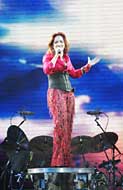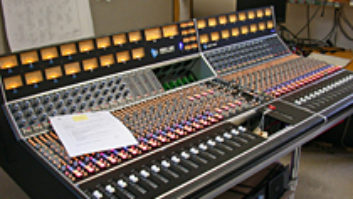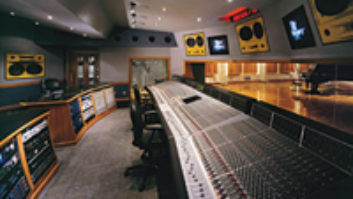
After eight years off the road, Gloria Estefan has returned, with her Live & Re-Wrapped 2004 tour, which winds up with two final sold-out nights at Miami’s American Airlines Arena in late September. But unlike other artists who run “farewell” tours year after year, Estefan insists that this current show is the end of her touring career, hoping to focus more on recording and spending time with her family. However, any Estefan show is a huge and complex performance, and we were able to catch up with front-of-house engineer Mark Dowdle and monitor engineer Craig Melvin at San Jose, Calif.’s HP Pavilion in late August.
“I feel fortunate to have the use of the kind of technology that allows me to do scenes for each song or scenes within a song, which can be remembered by the software in the console and recalled at will,” says Mark Dowdle, Clair Bros. crew chief and FOH engineer. While Dowdle relies mostly on the console for dynamics such as compression and gates, he does carry outboard gear such as a Lexicon 960, TC Electronic 2290 and M5000, AMS RMX-16 and a pair of Eventide H3500 Harmonizers. For Estefan’s vocals, he uses a pair of Avalon 737SP Producer Packs that have mic pre, EQ and compression in one unit. In addition, there is an Avalon AD2022 inserted on the bass guitar channels and an Alan Smart compressor on the console outputs.

For the Miami Sound Machine, Estefan’s ensemble — which has grown to more than 20 players including three percussionists, a full horn section and background vocalists — Dowdle uses an assortment of Audio-Technica, Sennheiser, Neumann, AKG, Shure and Electro-Voice mics. The Clair Bros. i4 house P.A. includes an array of 44 i4s and 44 i4Bs, eight P2s on the monitor thrust and eight S4 subs on the floor, all controlled by the Clair iO processing system, which, “is probably the most valuable piece of equipment I have out there,” Dowdle says. “With so many players who use a large assortment of instrumentation, as well as so many percussion instruments being used simultaneously, creating something musical out of so much information is a challenge. It’s difficult to get definition and clarity when you have that much information coming at you. It’s probably the most challenging situation I’ve had in my 30 years of mixing. It is extremely difficult, but pulling it off is extremely gratifying.”

Back row (L-R): Joe Doughtery, Clair Bros. FOH system engineer; Courtney Burger, Clair Bros. system tech; and Nyle Wood, Clair Bros. stage/system tech and candy supplier. Front row (L-R): Clair Bros. monitor system engineer Chris Fulton, FOH engineer Mark Dowdle and monitor engineer Craig Melvin
Monitor engineer Craig Melvin — who has been with Estefan since the late ’80s — is using a Sennheiser 865 capsule with an Evolution G2 RF system for Estefan’s vocal mic. “I introduced the capsule to her a year ago,” Melvin says. “We listened to other capsules, but she loved the accuracy of the 865. She especially likes what it does for her low-mid register. Gloria was one of the first to use Ear Monitors about 14 years ago and has never gone back. The keyboard player, one guitar player, three percussionists, the drummer and the violinist all use Future Sonics Ear Monitors. The five horn players, 10 dancers, three singers, bassist and second guitarist are using wedges. Front wedges and sidefills are for the dancers.
“Until a year ago,” he continues, “I used two analog consoles [4ks or a 4k and a Paragon] to deal with all the I/Os. Last year, Gloria added a third percussionist, a second guitarist and made the violin player a full-time member. She also added a Pro Tools system for embellishment tracks [backward guitar, radio voice, etc.] and the analog boards couldn’t keep up with the number of I/Os. Alan Richardson, Elton John’s monitor engineer, came on the first day of rehearsal and got me up to speed on the PM1D. He’s one of the most experienced PM1D users and his help was invaluable. The board let me get 22 wedge mixes together for band rehearsal, and during those rehearsals, I got my stereo ear mixes dialed-in. The onboard effects work fine and I only use a couple outboard pieces: a 224xl, an H3500, a Sony DRE S777 and a Focusrite 430 for Gloria.
“Overall, the PM1D makes this show a lot easier to deal with because of the scene recall. It can be challenging, though, when pasting changes and changing scenes need to happen simultaneously. At first, the latency of the board against the immediacy of the bone conduction in the ears bothered me, but I’ve gotten used to that. I do wish it had a de-esser though. As far as in-ears, I do think it’s advisable to stay onboard and not insert any external analog processing due to the latency of the extra conversion.”
Clair Bros. crew chief and FOH engineer Mark Dowdle, who has mixed Gloria Estefan since 1988, uses 116 inputs—96 for instrumentation and vocals and 20 for effects and playback—on a Yamaha PM1D.
FOH engineer Mark Dowdle is archiving each show on a pair of Sony PCM-3348 digital 48-track recorders. “I come out of the direct outs for each input and into three Yamaha AIO8s and back out to a pair of Euphonix converter boxes. From there, all the inputs are sent to the two machines via one [MADI] cable each. It’s user-friendly and works every day.”


